Pepper leaves turn yellow in the greenhouse: what to do to quickly and effectively solve the problem
Yellowed leaves in greenhouse peppers is a common problem caused by poor grooming. Yellowness serves as a signal that the bush is under severe stress and needs help. If you act decisively and quickly, the pepper can be helped by creating favorable external conditions and adding missing fertilizers to the soil.
The content of the article
Why do peppers in a greenhouse turn yellow leaves
The yellowing of the leaves in greenhouse peppers is often triggered by stress and mistakes of the gardener: the choice of poor-quality soil, a small amount of fertilizer applied or improper watering.
Sometimes yellowness indicates a viral disease or insect attack. To save the bushes, you need to accurately determine the cause of the color change.
Unsuitable microclimate
Peppers are extremely sensitive to temperature extremes. If the air in the greenhouse is cooled to + 12 ° C or more, the root system ceases to fully assimilate nutrients and moisture from the soil. The upper foliage depletes the lower foliage to survive. As a result, the leaves at the bottom of the bush wither, turn yellow and fly around.
The greenhouse needs to be ventilated up to 3 times a day so that the peppers get enough oxygen. To avoid hypothermia at night, it must be closed. An important role is played by the humidity indicator: overdried air causes yellowing of the leaves, and the formation of condensation on the walls of the greenhouse indicates dampness, which leads to rotting of peppers.
Watering errors
Peppers are a moisture-loving crop, so the gardener needs to monitor the soil moisture indicator. The optimal value is 80%.
The main mistakes that lead to yellow leaves: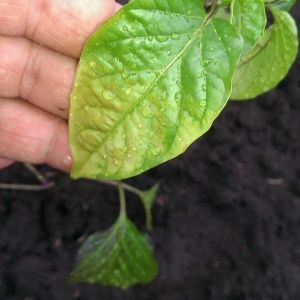
- Watering less than once every 4-5 days provokes drying out of the shoots: the leaves crack, lose color and fall off.
- The use of cold water is fraught with plant death. The roots are supercooled, the foliage turns yellow and falls off.
- Excessive watering causes a sharp increase in soil acidity. The consequences are rotting of the root system and yellowing of the lower leaves. These peppers often die.
Unsuitable soil
The most common the cause of the yellowness of the leaves - incorrectly selected type of soil. The main characteristics of a soil suitable for peppers:
- minimum salt concentration;
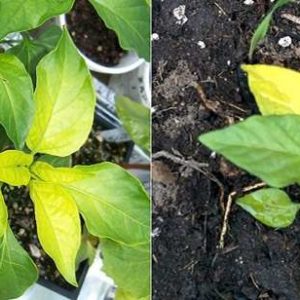
- low acidity - pH <7;
- high percentage of humus;
- low peat content;
- good indicators of moisture and air penetration.
The soil should have a sufficient amount of macro- and microelements. Based on the localization of yellowing, it is possible to determine which mineral is lacking in peppers:
- The yellowness of the upper leaves indicates a lack of nitrogen nutrition. An additional symptom is the general fading of the shoots and slow growth. If you do not feed the pepper with nitrogen, the bush will die within 7-10 days.
- Yellowing and curvature at the base is a sign of a lack of boron. In case of long-term shortage of this microelement, the peppers will stop tying.
- If a leaves curl and change color at the edges, which means there is a potassium deficiency.
- The appearance of protruding veins and the yellowness of the core of the leaf indicates a lack of iron.
- If the veins remain green and the leaf surface turns yellow, the pepper is not getting enough manganese from the soil. This will be followed by drying of the lower parts of the bush, and then the upper ones.
Post-transplant stress
Transplanting is always stressful for the plant, especially if the wrong soil is selected or the root system of the pepper is poorly developed. A slight yellowing in the early stages shouldn't be a big deal, but it's important to make sure the shrub is getting all the nutrients it needs and enough moisture.
To make the transplant process less painful, summer residents use various adaptogens and biostimulants ("Epin-extra", "Zircon", "Silk", etc.).
Diseases and pests
Yellowing can be caused by a viral disease called mosaic. A characteristic feature is light yellow specks on the leaves of pepper, which grow and merge over time. At an advanced stage, yellowness spreads to the fruit. Infection occurs through open lesions. Infectious agents can be in the soil for a long time and infect neighboring plants.
Main vectors:
- aphid;
- soil nematodes;
- ticks.
Fungus or pathogenic bacteria can also cause yellowing. Insects also cause yellow peppers. The warmth, lack of wind and the presence of shade attract pests to the greenhouse. The most dangerous period for peppers is the flowering time. Pests sit on leaves and devour them. As a result, the lack of juice gradually leads to the yellowness of the shoots, and then to their death.
Often the main pest for peppers, a spider mite appears. Typical signs of its presence:
- cobweb under the leaves;
- the appearance of small yellow dots on the outside of the leaves;
- yellow leaves fall off after 2 days;
- complete baldness of the bush occurs in 3-5 days.
What to do
Treatment methods vary depending on the cause of the yellowness. If the problem is provoked by a deficiency of micro- or macroelements, it is necessary to make top dressing.
The main recommendations of gardeners are presented in the table:
| The element that pepper is missing | Algorithm of actions |
|---|---|
| Nitrogen | A solution of ammonium nitrate is introduced at the root. Recommended proportions: 15-30 g of powder per 10 liters of water. |
| Boron | The bush is sprayed with a mixture of orthoboric acid and water. The proportion is 1: 1. |
| Potassium | For spraying, potassium nitrate is used, diluted in water in a ratio of 2: 1. |
| Iron | The foliage is sprayed with ferrous sulfate. The remaining liquid can be used as root dressing. |
| Manganese | In 10 liters of water, 5 g of manganese sulfate are diluted. The solution is used to spray the peppers. |
After 2-3 days after applying top dressing, the drying of the bush slows down. After a week, the process of color regeneration and restoration starts. Pepper slowly assimilates fertilizers, therefore it is pointless to wait for an instant effect.
When yellowness is provoked by other reasons, use the following recommendations of experienced gardeners:
- If the problem of yellowing of the shoots is caused by cold, you need to additionally insulate the pepper with a film overnight. An alternative option is to apply abundant manure. It is important to constantly monitor the temperature in the greenhouse.
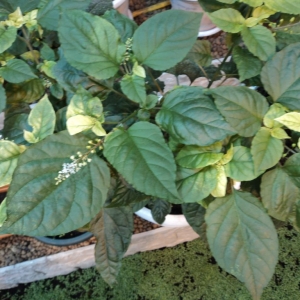
- Water the bushes with warm water 3 times a week.
- To reduce the risk of mosaic infestation, use only quality seeds and regularly disinfect equipment and shoes.
- If yellowing is caused by stress, it is best to use artificial analogs of natural biostimulants, which enhance the natural defenses of plants against aggressive environmental factors. For example, the drug "Epin" is suitable.
When trying to help a plant, it is important not to overdo it. The irregular application of fertilizers, additives and constant spraying with preparations has the opposite effect.
Leaves of seedlings turn yellow
Seedlings are more sensitive to aggressive environmental factors than adult peppers, therefore, the problem of yellowing primarily concerns young plants. If the root cause is not eliminated in time, vegetables will die.
The reasons
The reasons for the yellowing of seedlings and adult bushes are similar:
- Transplant into improperly selected soil.
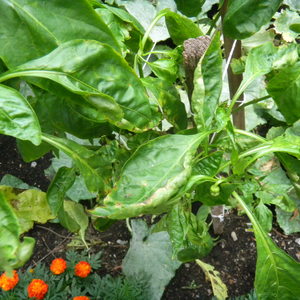
- Insufficient watering.
- Failure to comply with the temperature regime.Basic rules for seedlings: less than + 12 ° С - seedlings will not grow, more than + 35 ° С - they will dry out and turn yellow. Optimum indicators are + 15 ... + 25 ° С.
- Constant exposure to direct sunlight that causes burns. Only partial shade or diffused light is suitable for seedlings.
Spider mites pose the greatest danger to seedlings, therefore it must be constantly examined. Small pests are difficult to spot.
What to do
How to help yellowed seedlings? Key recommendations:
- Monitor the temperature of the soil and air constantly.
- Cover young peppers overnight to protect them from the cold. Effectively sprinkle ashes on the soil to increase the frost resistance of the seedlings.
- You can destroy the tick with Akarin or Kleschevit.
- The popular way to combat pests is infusion: a 3-liter jar contains ½ kg of finely chopped garlic cloves. For spraying, 15 ml of infusion is diluted in 2.5 liters of water.
It is important to analyze the soil in order to avoid a deficiency of nutrients in the future.
Prevention measures
The following preventive measures are suitable for peppers to help protect the leaves from yellowing:
- before planting, seeds and soil are disinfected;
- only healthy seedlings are planted in the greenhouse;
- when buying seeds, they choose types of peppers that are resistant to viruses and pests;
- peppers are regularly sprayed with mixtures made from microbial-resistant plants.
It is also important to decontaminate the greenhouse room and the tools used to care for the plants.
Tips from experienced summer residents
To grow healthy peppers and avoid yellowing of the leaves, follow these guidelines: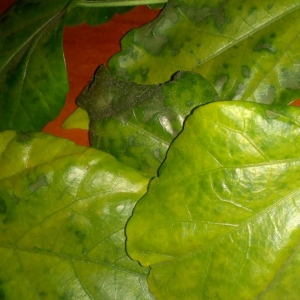
- Plant the seeds in trenches 8-9 cm deep, keeping the optimum distance between bushes 16-18 cm.
- Mulch the beds with grass and ash.
- Use a soil containing sand, low peat, horse manure, and turf in a 1: 1: 1: 2 ratio.
- Do not apply too much fertilizer to the ground before planting bushes. If you follow the crop rotation, the soil will have a sufficient amount of nutrients.
- Add potash and phosphate fertilizers to the soil during the fall months during plowing.
- Put the set norm of nitrogen completely into the soil during the growing season of the peppers.
- Analyze the composition of the soil before adding fertilizer.
Conclusion
The yellowing of the shoots is not a verdict for the pepper, so the crop can be saved. To determine the cause, determine the temperature in the greenhouse, inspect the bushes for pests, and analyze the composition of the soil.
The more regular the inspections are, the more likely you are to notice negative changes in the early stages and prevent the death of the crop.